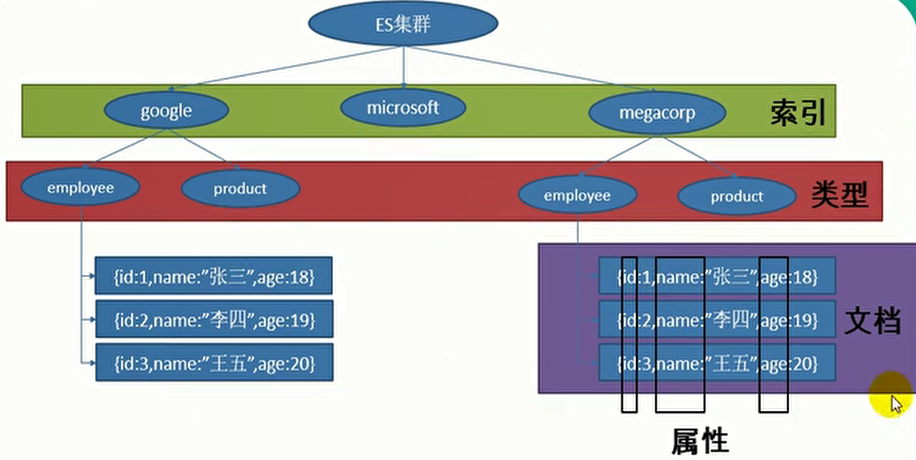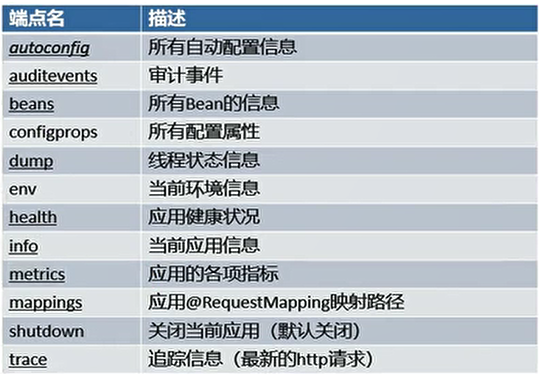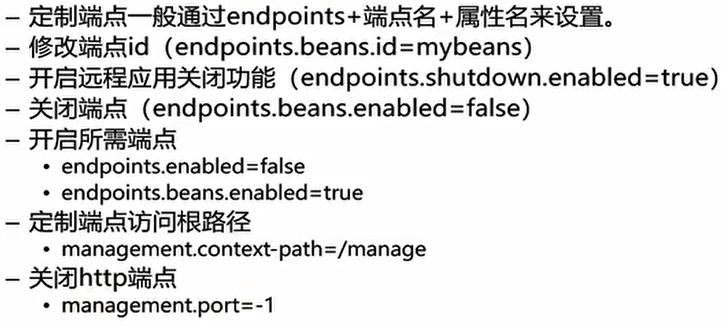iwehdio的博客园:https://www.cnblogs.com/iwehdio/
1、检索
-
ElasticSearch:开源的全文搜索引擎,是一个分布式搜索服务,提供Restful API。
-
搭建环境:
-
下载镜像:
docker pull hub-mirror.c.163.com/library/elasticsearch -
运行镜像(默认web通信9200端口,分布式各个节点使用9300端口通信):
docker run -e ES_JAVA_OPTS="-Xms256m -Xmx256m" -d -p 9200:9200 -p 9300:9300 --name ES01 5acf0e8da90b -
访问9200端口,显示响应的JSON数据。
-
-
ElasticSearch快速入门:
-
ElasticSearch是面向文档的,存储整个对象或文档。JSON作为文档的序列化格式。
-
索引:存储数据到ES中的行为叫做索引。但在索引一个文档之前,需要确定将文档存储在哪里。
-
一个ES集群可以包含多个索引,每个索引可以包含多个类型,不同类型下存储着多个文档,每个文档又有多个属性。(其实就对应MySQL中的MySQL、数据库、表、行、列)

-
向ES中保存文档,以保存一个员工为例:
-
以PUT请求发送uri:/megacorp/employee/1。请求体的内容是员工对象的JSON数据。(完整url为:ip地址:9200/megacorp/employee/1)
{ "first_name" : "John", "last_name" : "Smith", "age" : 25, "about" : "I love to go rock climbing", "interests": [ "sports", "music" ] } -
megacorp表示索引名称,employee表示类型名称,1表示员工的id。
-
响应JSON数据:
{ "_index": "megacorp", "_type": "employee", "_id": "1", "_version": 1, "result": "created", "_shards": { "total": 2, "successful": 1, "failed": 0 }, "created": true } -
更新员工只需要再次发送PUT请求。
-
-
从ES中检索员工:
-
以GET请求发送uri:/megacorp/employee/3。
-
响应JSON数据:
{ "_index": "megacorp", "_type": "employee", "_id": "3", "_version": 1, "found": true, "_source": { "first_name": "Douglas", "last_name": "Fir", "age": 35, "about": "I like to build cabinets", "interests": [ "forestry" ] } }
-
-
从ES中删除员工:
-
以DELETE请求发送uri:/megacorp/employee/3。
-
响应JSON:
{ "found": true, "_index": "megacorp", "_type": "employee", "_id": "3", "_version": 2, "result": "deleted", "_shards": { "total": 2, "successful": 1, "failed": 0 } }
-
-
从ES中检查员工是否存在:
- 以HEAD请求发送uri:/megacorp/employee/3。
- 若存在则返回状态码为200,不存在返回404。
-
从ES中搜索所有员工:
-
以GET请求发送uri:/megacorp/employee/_search。
-
响应JSON:
{ "took": 43, "timed_out": false, "_shards": { "total": 5, "successful": 5, "skipped": 0, "failed": 0 }, "hits": { "total": 2, "max_score": 1, "hits": [ { "_index": "megacorp", "_type": "employee", "_id": "2", "_score": 1, "_source": { "first_name": "Jane", "last_name": "Smith", "age": 32, "about": "I like to collect rock albums", "interests": [ "music" ] } }, { "_index": "megacorp", "_type": "employee", "_id": "1", "_score": 1, "_source": { "first_name": "John", "last_name": "Smith", "age": 25, "about": "I love to go rock climbing", "interests": [ "sports", "music" ] } } ] } }
-
-
搜索一个last_name为Smith的员工,使用查询字符串q:
- 以GET请求发送uri:/megacorp/employee/_search?q=last_name:Smith。
-
使用查询表达式:
-
以POST请求发送uri:/megacorp/employee/_search。
-
在请求体中,使用一个JSON请求,匹配last_name为Smith的员工:
{ "query" : { "match" : { "last_name" : "Smith" } } } -
更复杂的表达式,过滤出年龄大于30的:
{ "query" : { "bool": { "must": { "match" : { "last_name" : "smith" } }, "filter": { "range" : { "age" : { "gt" : 30 } } } } } } -
全文搜索,两个单词中有任意一个都会被检索到,但是会评判相关性:
{ "query" : { "match" : { "about" : "rock climbing" } } } -
短语搜索,两个单词当作一个短语,搜索出的结果必须完整的匹配:
{ "query" : { "match_phrase" : { "about" : "rock climbing" } } } -
高亮搜索,指定高亮的字段,返回值会被
<em>标签封装:{ "query" : { "match_phrase" : { "about" : "rock climbing" } }, "highlight": { "fields" : { "about" : {} } } }
-
-
-
springboot整合ES:
-
默认使用springData操作ES。
-
自动配置:
-
默认支持两种技术与ES交互:Jest和SpringData ElasticSearch。
-
Jest默认不生效,需要导入工具包。
<dependency> <groupId>io.searchbox</groupId> <artifactId>jest</artifactId> </dependency> -
SpringData ElasticSearch:
- 自动配置了客户端,需要配置节点信息。
- ElasticsearchTemplate操作es。
- 编写 ElasticsearchRepository的子接口操作ES。
-
-
Jest操作ES:
-
配置文件:
spring.elasticsearch.jest.uris=http://ip地址:9200 -
创建实体类,id需要加上
@JestId注解:public class Article { @JestId private Integer id; private String author; private String title; private String content; /* getter & setter */ } -
添加文档到ES,创建一个Index:
@Autowired JestClient jestClient; @Test public void contextLoads() { Article article = new Article(); article.setId(1); article.setAuthor("liu"); //保存一个文档,指定索引和类型 Index index = new Index.Builder(article).index("atguigui").type("news").build(); try { jestClient.execute(index); } catch (IOException e) { e.printStackTrace(); } } -
访问url:ip地址:9200/atguigui/news/1即可查询到添加的文档。
-
在ES中搜索文档:
@Test public void search() { String json = "{ " + " "query" : { " + " "match" : { " + " "author" : "liu" " + " } " + " } " + "}"; //传入搜索的表达式,指定索引和类型 Search search = new Search.Builder(json).addIndex("atguigui").addType("news").build(); try { SearchResult result = jestClient.execute(search); System.out.println(result.getJsonString()); } catch (IOException e) { e.printStackTrace(); } }
-
-
SpringData ElasticSearch操作ES:
-
配置文件:
spring.data.elasticsearch.cluster-name=elasticsearch spring.data.elasticsearch.cluster-nodes=ip地址:9301 -
在实体类上用注解指定索引和类型:
@Document(indexName = "atguigu",type = "article") public class Article { private Integer id; private String author; private String title; private String content; /* getter & setter */ } -
创建接口,泛型为bean的数据类型和主键类型:
public interface ArticleRepository extends ElasticsearchRepository<Article, Integer> { }- 也可以像JPA一样,按照命名规则写方法名,自动实现。比如
findByAuthorLike()。
- 也可以像JPA一样,按照命名规则写方法名,自动实现。比如
-
此处需要Springboot的SpringData ElasticSearch与ES版本一致:
docker pull hub-mirror.c.163.com/library/elasticsearch:2.4.6 docker run -e ES_JAVA_OPTS="-Xms256m -Xmx256m" -d -p 9201:9200 -p 9301:9300 --name ES02 5e9d896dc62c -
访问url:ip地址:9201/atguigu/article/3即可查询到添加的文档。
-
-
2、任务
-
异步任务:
-
同步任务的情况,必须按照顺序一个一个执行。
-
service:
@Service public class AsyncService { public void hello() { try { Thread.sleep(3000); } catch (InterruptedException e) { e.printStackTrace(); } System.out.println("处理数据中..."); } } -
controller:
@RestController public class AsyncController { @Autowired AsyncService asyncService; @GetMapping("/hello") public String hello() { asyncService.hello(); return "success"; } } -
这样的话,每次访问/hello,都要等待三秒才会显示success。
-
在service的hello方法上添加一个
@Async注解,就告诉Springboot这是一个异步方法。就会自动开启一个线程池进行调用。这样就不需要等待3秒了。 -
需要先在主方法上开启异步注解功能:
@EnableAsync。
-
-
定时任务:
- 在主方法上开启定时任务注解功能:
@EnableScheduling。 - 在service的方法上使用
@Scheduled注解的cron属性指定定时执行的时间。- 表达式由分隔开的字符组成,按顺序分别为秒、分钟、小时、一月中的第几天、月、一周中的第几天。
- 如
0 * * ? * MON-FRI表示在周一到周五每分钟的0秒启动一次。 - 表达式中
,表示枚举,0,1,2表示0、1、2秒。 - 表达式中
-表示区间,0-8表示0~8秒。 - 表达式中
/表示步长,0/4表示每4秒。 L表示最后一个,W表示工作日,?表示周的天与月的天的冲突匹配。
- 在主方法上开启定时任务注解功能:
-
邮件任务:
-
引入依赖:spring-boot-starter-mail。
-
配置文件:
spring.mail.username=邮箱1 spring.mail.password=授权码 spring.mail.host=smtp.qq.com spring.mail.properties.mail.smtp.ssl.enable=true -
测试发送:
@Autowired JavaMailSenderImpl mailSenderl; @Test public void contextLoads() { SimpleMailMessage message = new SimpleMailMessage(); message.setSubject("通知"); message.setText("12点"); message.setTo("邮箱2"); message.setFrom("邮箱1"); mailSenderl.send(message); } -
带附件的复杂邮件:
@Test public void contextLoads2() throws MessagingException { MimeMessage mimeMessage = mailSenderl.createMimeMessage(); MimeMessageHelper helper = new MimeMessageHelper(mimeMessage,true); helper.setSubject("通知"); helper.setText("12点"); helper.setTo("邮箱2"); helper.setFrom("邮箱1"); //上传文件 helper.addAttachment("1.jpg",new File("C:\Users\iwehdio\Pictures\001.png")); mailSenderl.send(mimeMessage); }
-
3、安全
-
SpringSecurity的两个主要功能是认证和授权:
- 认证:根据用户名和密码认证用户。
- 授权:确定一个主体是否有执行某个动作的权限。
-
引入SpringSecurity:
-
导入依赖:spring-boot-starter-security。
-
编写SpringSecurity配置类:
@EnableWebSecurity public class MySecurityConfig extends WebSecurityConfigurerAdapter { //定义授权规则 @Override protected void configure(HttpSecurity http) throws Exception { //定制请求的授权规则 http.authorizeRequests().antMatchers("/").permitAll() //首页允许所有人访问 .antMatchers("/level1/**").hasRole("VIP1") //不同level下的需要不同权限 .antMatchers("/level2/**").hasRole("VIP2") .antMatchers("/level3/**").hasRole("VIP3"); //开启登录功能。/login来到登录页,重定向到/login?error表示登录失败。 //如果没有登录,没有权限就会来到登录页面。默认post方式的 http.formLogin(); //设置来到自定义的登录页面 //开启自动配置的注销功能,/logout表示用户注销,清空session,注销成功到/login?logout。 http.logout().logoutSuccessUrl("/"); //注销成功来到首页,否则默认到登录页 //开启记住我功能,关闭浏览器后再打开仍然保持登录,通过Cookie实现 http.rememberMe(); } //定义认证规则 @Override protected void configure(AuthenticationManagerBuilder auth) throws Exception { //分配用户名密码和角色 auth.inMemoryAuthentication() .withUser("zhangsan").password("123").roles("VIP1","VIP2") .and() .withUser("lisi").password("456").roles("VIP2","VIP3"); } } -
前端页面根据权限进行显示:
-
sec:authorize属性中判断是否已认证、有何种权限。 -
sec:authentication属性中获取认证信息。<div sec:authorize="!isAuthenticated()"> <h2 align="center">游客您好,如果想查看武林秘籍 <a th:href="@{/login}">请登录</a></h2> </div> <div sec:authorize="isAuthenticated()"> <h2><span sec:authentication="name"></span>,您好。您的角色有 <span sec:authentication="principal.authorities"></span></h2> <form th:action="@{/logout}" method="post"> <input type="submit" value="注销" /> </form> </div> <div sec:authorize="hasRole('VIP1')"> <h3>普通武功秘籍</h3> <ul> <li><a th:href="@{/level1/1}">罗汉拳</a></li> <li><a th:href="@{/level1/2}">武当长拳</a></li> <li><a th:href="@{/level1/3}">全真剑法</a></li> </ul> </div>
-
-
定制自己的登录页面:
-
前端:
<div align="center"> <form th:action="@{/userlogin}" method="post"> 用户名:<input name="user"/><br> 密码:<input name="pwd"><br/> <input type="checkbox" name="remember"> 记住我 <br/> <input type="submit" value="登陆"> </form> </div> -
后端处理:
//设置前端表单提交的name值与用户名密码的对应 //设置定制登录页面的地址(get方式) //设置登录表单提交的地址(post方式) http.formLogin().usernameParameter("user").passwordParameter("pwd").loginPage("/userlogin").loginProcessingUrl("/userlogin"); //设置前端表单提交的name值与记住我的对应 http.rememberMe().rememberMeParameter("remember");
-
-
4、分布式
-
ZooKeeper:注册中心,开源的分布式应用程序协调服务。是一个为分布式应用提供一致性服务的软件,提供包括配置维护、域名服务、分布式同步和组服务等。
-
Dubbo:开源的分布式服务框架,按照分层的方式架构,使各个层之间解耦合。从服务模型的角度看,可以抽象为提供方提供服务和消费方消费服务。

-
docker安装ZooKeeper:
docker pull zookeeper-
运行镜像:
docker run --name zk03 -p 2181:2181 --restart always -d 6ad6cb039dfa -
2181端口与客户端交互,2888端口集群,3888端口选举。
-
-
SpringBoot整合Dubbo:
-
创建服务提供者模块:
public interface TicketService { public String getTicket(); } @Component @Service //Dubbo的@Service注解 public class TicketServiceImpl implements TicketService { @Override public String getTicket() { return "《1234》"; } } -
创建服务消费者模块。同时需要将服务提供者的接口放入相同结构的包下。一定要注意,服务提供者和服务消费者模块中的TicketService的全类名一定要完全相同,不然会报错:
@Service //Spring的注解 public class UserService { @Reference TicketService ticketService; public void hello(){ String ticket = ticketService.getTicket(); System.out.println("买到票了"+ticket); } } -
导入Dubbo和ZooKeeper的客户端工具的starter(两个模块都要导入):
<dependency> <groupId>com.alibaba.boot</groupId> <artifactId>dubbo-spring-boot-starter</artifactId> <version>0.1.0</version> </dependency> <dependency> <groupId>com.github.sgroschupf</groupId> <artifactId>zkclient</artifactId> <version>0.1</version> </dependency> -
相关配置:
-
配置文件:配置当前应用的名称、注册中心的地址、将那个包发布出去。
#服务提供者配置 dubbo.application.name=provider dubbo.registry.address=zookeeper://ip地址:2181 dubbo.scan.base-packages=cn.iwehdio.ticket.service #服务消费者配置 dubbo.application.name=consumer dubbo.registry.address=zookeeper://ip地址:2181
-
-
测试:
@Autowired UserService userService; @Test public void contextLoads() { userService.hello(); } -
使用流程:
- 使用Dubbo将服务提供者注册到注册中心ZooKeeper中。
- 配置Dubbo扫描包和注册中心地址。
- 将服务发布出去:在服务提供者的TicketServiceImpl上加Dubbo的
@Service注解。
- 消费者要消费服务,从注册中心中订阅服务。使用Dubbo,消费者调用提供者的服务。
- 使用
@Reference注解获取订阅的服务。
- 使用
- 使用Dubbo将服务提供者注册到注册中心ZooKeeper中。
-
-
SpringCloud:是一个分布式的整体解决方案。
- 五大常用组件:服务发现、客服端负载均衡、断路器、服务网关和分布式配置。
-
SpringBoot整合SpringCloud:
-
创建模块Eureka service注册中心:
-
配置文件:
server: port: 8761 eureka: instance: hostname: eureka-server #eureka实例的主机名 client: register-with-eureka: false #不注册本身 fetch-registry: false #不从eureka上获取服务的注册信息 service-url: defaultZone: http://localhost:8761/eureka/ -
在主程序上配置注解:
@EnableEurekaServer启用注册中心。 -
访问localhost:8761可以访问注册中心。
-
-
创建模块Eureka discovery服务发现的提供者:
-
SpringCloud整合微服务是通过HTTP通信的,创建服务和控制器:
@Service public class TicketService { public String getTicket() { return "《1234》"; } } @RestController public class TicketController { @Autowired TicketService ticketService; @GetMapping("/ticket") public String getTicket() { return ticketService.getTicket(); } } -
配置文件将服务注册到注册中心中:
server: port: 8001 spring: application: name: provider eureka: instance: prefer-ip-address: true #使用IP地址进行注册 client: service-url: defaultZone: http://localhost:8761/eureka/ -
访问localhost:8001/ticket可以访问请求,并获取到响应。
-
-
创建模块Eureka discovery服务发现的消费者:
-
配置文件:
spring: application: name: consumer server: port: 8200 eureka: instance: prefer-ip-address: true #使用IP地址进行注册 client: service-url: defaultZone: http://localhost:8761/eureka/ -
在主程序中开启服务发现,并且创建发送HTTP请求的RestTemplate:
@SpringBootApplication @EnableDiscoveryClient public class ConsumerApplication { public static void main(String[] args) { SpringApplication.run(ConsumerApplication.class, args); } @LoadBalanced @Bean public RestTemplate restTemplate() { return new RestTemplate(); } } -
控制器处理相应的请求,并且用RestTemplate发送HTTP请求给服务提供者:
@RestController public class UserController { @Autowired RestTemplate restTemplate; @GetMapping("/buy") public String buyTicket() { String s = restTemplate.getForObject("http://provider/ticket",String.class); return "买了" + s; } } -
访问localhost:8200/buy可以访问请求,并获取到响应。
-
此时可以在注册中心中看到注册的提供者和消费者。
-
-
5、热部署/监控管理
-
在修改Java文件后,不重启应用的情况下,程序可以自动部署(热部署)。
-
可以使用SpringBoot Devtools,依赖为spring-boot-devtools。
-
如果有修改Java代码,热部署之前需要Ctrl+F9重新Build。
-
通过引入spring-boot-starter-actuator,提供准生产环境下的应用监控和管理功能。
-
直接在浏览器查询,需要配置文件:
management.security.enabled=false -
监控和管理端点:

-
定制端点:

iwehdio的博客园:https://www.cnblogs.com/iwehdio/